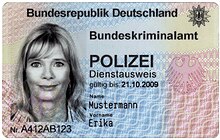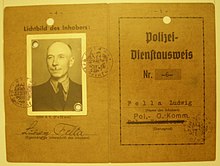Police ID card
Police badges inform the holder by a personalized document as a service force of police from. Statutory measures may only be carried out by law enforcement officers or specially authorized police members (e.g. use of direct coercion by employees of the identification service ).
Also, employees and civil servants of the police in some countries have police badges.
Examples
An example from the country Berlin : Here are the cards know for trainees, for officials of the police green, detectives carry red identity cards, employees yellow and gray office ID cards are issued for the administrative staff.
In Schleswig-Holstein, the ID cards of the enforcement officers are held in a dark blue-green tone, while those of the employees and administrative officers are in a light green. Apart from the coloring, the career affiliation can also be recognized by the given official title, but hardly for outsiders; the chief government inspector, for example, corresponds to the police chief commissioner (both occupation group A10, senior service).
The ID cards are printed either on paper or on plastic cards. The ID cards are different for each police station. The Lower Saxony and Bavaria police are still holding on to the paper ID card. Some police forces use chip cards , these can be coded differently.
The ID card shows the police officer , the family name and first name, the official title , if applicable, the service number and a photo of the owner. The official's signature and the official seal of the employing department are also found on the old ID .
The ID cards partly replace the former criminal service stamps . These minted, mostly oval coins made of metal had a long tradition all over the world.
A high level of protection against forgery is achieved through the use of indexed colors during printing in conjunction with security features.
The identification requirement of police officers is regulated differently or not at all in the relevant federal and state laws; but then maybe in supplementary (service) regulations. The general identification requirement can also be restricted there. Take North Rhine-Westphalia as an example: there, police officers have to show their ID cards when performing official acts, but when working in civilian clothes they have to do this without being asked. The ID does not need to be shown if the purpose of the official act is impaired by it or is endangered by the showing of the police officer (RdErl. Of the Ministry of the Interior of May 28, 2003 "Police service IDs, criminal service stamps and business cards").
In case of doubt, the authenticity of the ID can be checked at the local police station. For this, the inquiring should pick out the phone number of the police themselves from the phone book or in the directory assistance follow-through. If there is justified suspicion of dubiousness, emergency number 110 can also be used. The police need the name of the holder and the issuing authority of the ID card to check its legality.



